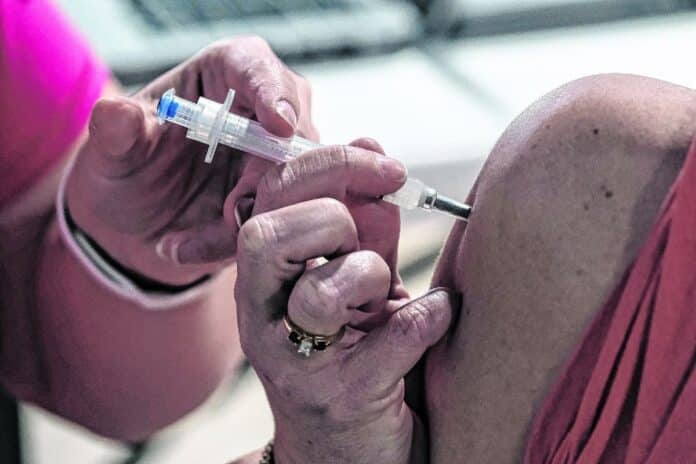
Even with coronavirus vaccine shots now in the arms of more than 1 in 3 Bartholomew County residents, local health officials are anticipating a difficult time reaching herd immunity — the threshold experts believe is needed to stop uncontrolled spread of COVID-19.
Herd immunity occurs when a disease can no longer spread easily within a population because enough people have acquired immunity through vaccination or previous infection, according to the Centers for Disease Control and Prevention.
If enough people are immune, experts say, the virus will have nowhere to go, infection rates will fall and the disease will start to fade away.
Currently, nobody knows for sure what the benchmark is for the coronavirus that causes COVID-19, but most infectious disease experts agree that at least 70% to 80% of the population will need to be immune to achieve herd immunity.
In Bartholomew County, that would translate to somewhere between 58,645 and 67,023 people based on population estimates from the U.S. Census Bureau.
Right now, Bartholomew County isn’t close to reaching that target, and local health officials are already concerned that too many people will choose not to get vaccinated against a virus that has killed over 565,435 people in the U.S., including at least 155 in Bartholomew County.
As of Friday morning, a total of 28,645 Bartholomew County residents had received at least one COVID-19 shot and an additional 1,012 had received the single-shot Johnson & Johnson vaccine before it was paused earlier this week — roughly 35% of the county’s total population, according to state records.
A total of 19,137 Bartholomew County residents were fully vaccinated as of Friday morning, or about 23% of the county’s population.
Additionally, the number of local residents becoming fully vaccinated per week has increased for the past four weeks on record, reaching 2,241 the week ending April 11, according to state records.
If that week’s pace were to continue, Bartholomew County would start approaching the lower range of the herd immunity estimate by late August.
However, the upper range would require more people in Bartholomew County to be vaccinated than are currently authorized under federal requirements of being at least 16 years old.
Currently, around 66,180 people in Bartholomew County are age 16 and up, or about 79% of the county’s population.
Conversely, about 89% of local residents who meet current age requirements would need to get immunized for the county to reach 70%.
But those figures don’t include the uncertainties experts have over how long immunity lasts, how future mutations of the virus will impact the effectiveness of vaccines and how many people will ultimately refuse to get vaccinated.
“I’m going to be a realist and say that number probably won’t be achieved,” said Dr. Brian Niedbalski, Bartholomew County health officer. “…I don’t know if we will reach 70% in our county.”
Niedbalski said the county would likely fall short of the mark because too many people will choose not to get vaccinated and uncertainty about how long immunity will last. But he emphasized that the shots are “significantly reducing serious illness” in Bartholomew County, largely attributing the decrease in hospitalizations at Columbus Regional Hospital over the past few months to the vaccines.
“It will be extremely difficult to have a grasp for how many people are immune at a set point in time,” Niedbalski said.
The comments from Niedbalski come as health officials in several states report noticeable dips in vaccine interest, The Associated Press reported.
About 1 in 4 U.S. adults say they probably or definitely won’t get vaccinated, according to an Associated Press-NORC Center for Public Affairs Research poll conducted in February.
The situation, experts say, is particularly worrisome as more virulent and contagious strains of the virus are taking root in the U.S., including Indiana.
Vaccine hesitancy
And some potential signs of vaccine hesitancy have started to emerge locally.
Just over a week ago, the Jackson County Health Department decided to move a mass vaccination clinic from Seymour High School to the health department’s office because demand was much lower than anticipated, said Lynn Montgomery, the department’s public health coordinator.
“We were prepared to administer 700 doses, but the response was not what we anticipated, and so we ended up doing less than 100,” Montgomery said.
A mass vaccination clinic held around the same time at the Bartholomew County 4-H Fairgrounds fared much better, but still gave out 376 fewer shots than the 1,300 doses that officials had said they were prepared to administer.
“There are too many people who are flat out against the vaccine or have been misinformed about the vaccine,” Niedbalski said. “I’m also seeing people who have contracted COVID refuse to get vaccinated. They want to ride out their natural immunity. That’s understandable, but it’s assumed antibodies last about six months. What if it’s less than that? Then what happens? Do antibodies protect an individual from variants, which are suspected to be the dominant strain at this time? We don’t know. Many unknowns remain. We just don’t have enough data now. What is known is the vaccine does prevent serious disease.”
However, demand for vaccines in Bartholomew County remains high, though it’s anyone’s guess how long that will last, said Dr. Slade Crowder, Columbus Regional Health vice president of physician enterprise operations and associate chief medical officer.
“We still have plenty of demand for vaccine and people waiting to get vaccinated,” Crowder said. “…But I do think there’s going to come a day where we’re going to have to push demand, and I don’t know when that will be.”
“Will that happen at 50% immunized and then it will be a struggle to get another 25%, or will we get to 75% before we have to really try to help push the demand?” Crowder added.
But even if Bartholomew County and the state of Indiana were to reach the 70% threshold, it does not necessarily mean the pandemic will go away for good.
“That doesn’t get us to herd immunity,” said Thomas Duszynski, an epidemiologist at the Richard M. Fairbanks School of Public Health at IUPUI. “It would if we just had the population of the state of Indiana and nobody came in and nobody left the state. We have to think globally when we’re talking about a pandemic.”
Worldwide numbers
Around 860 million doses of COVID-19 vaccines had been administered worldwide as of Friday morning — about 11% of the world’s total population —according to the Our World in Data project by the University of Oxford, which compiles vaccination statistics from official government sources around the world.
However, vaccine distribution worldwide has varied greatly by country, with wealthier countries buying up most of the doses so far.
As of this month, the world’s high-income countries have purchased 53% of the 8.6 billion doses of COVID-19 vaccines available globally despite only representing 16% of the world’s population, according to research from the Duke University Global Health Innovation Center.
At the current rate, the world’s 92 poorest countries may not reach a vaccination rate of 60% until 2023, according to the Duke University researchers.
Public health experts across the world fear that the virus will continue to circulate among unvaccinated populations and could eventually mutate to the point that vaccines are no longer effective.
“Every time somebody gets infected, there’s an opportunity for mutation to happen,” Duszynski said.
The fight against COVID-19 is far from over, according to experts who predict that the virus will likely still circulate even after the pandemic ends.
“My suspicion is that COVID-19 will remain among us, endemic much like influenza,” Niedbalski said. “We still need to wait on the data to confirm it though. I believe there is a potential to see additional variants that could cause surges from time to time. We may not be protected from these variants by previous natural infection or current vaccines. This may become the new normal as we attempt to adapt to variants with the use of updated yearly vaccines.”
— The Associated Press contributed to this report.
[sc:pullout-title pullout-title=”Mass vaccination clinic” ][sc:pullout-text-begin]
INDIANAPOLIS — The Indiana Department of Health announced free COVID-19 vaccinations will be offered at the Indianapolis Motor Speedway without an appointment today.
The speedway is offering the Moderna vaccine from 9 a.m. to 7 p.m. Individuals should enter through Gate 2 off 16th Street. Additional appointments are available at the speedway later this month and can be scheduled at https://ourshot.in.gov. Second-dose appointments will be scheduled at the time of the first dose and will be offered at Lucas Oil Stadium.
[sc:pullout-text-end]




